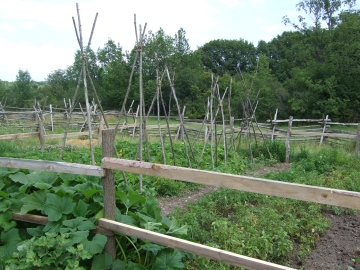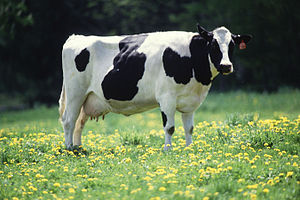THE STORY BEHIND THE STORY
Caroline receives a letter asking her to come and help on Uncle Aaron’s farm. Although she hates to leave her family, Caroline is pleased to see her cousin Lydia—and to meet Lydia’s pretty cow and sweet baby calf! Determined to help out in any way she can, Caroline keeps watch when a thief starts sneaking around the farm. Then she makes an unexpected discovery—and learns that some things are not as simple as they seem.

I had a lot of flexibility when developing a plan for Caroline Abbott’s six books, which was great! However, I did try to include familiar themes in Caroline’s stories. Traditionally, the six-book sets created for American Girl’s historical characters have ended with a “Changes” book. I liked the idea of giving Caroline new ways to grow and change, so I decided to take her away—temporarily!—from her beloved Lake Ontario. When the book begins, Caroline receives a summons to help at her cousin Lydia’s brand new family farm.
To learn more about farm life in rural New York two hundred years ago, I visited the Pioneer Farm at Genesee Country Village.

Since Caroline and Lydia were responsible for kitchen chores, I enjoyed chatting with the interpreter about period cooking and baking.
Since I spent twelve years working at Old World Wisconsin, an outdoor museum that includes nine restored farms, I was pretty comfortable writing about farm life. And when my colleagues at American Girl suggested including a calf, I was excited by the opportunity to learn more about old breeds of cattle.
Modern farmers tend to raise only a few breeds of cows, pigs, sheep, and other livestock. For example, Holstein cows are the most popular on dairy farms today. Holsteins don’t provide the richest milk, but they provide more milk than any other breed.
Lots of very old breeds of livestock are in danger of becoming extinct. Historic sites around the world play an important role in saving rare breeds from extinction. To learn more about cattle in Caroline’s era, I looked at the breeds being raised at Colonial Williamsburg in Virginia. (Curious? You can learn more about Colonial Williamsburg’s Rare Breeds Program here.) Since that site interprets a period before the War of 1812, I could be confident that the animals they raise were known in the United States in Caroline’s time.
I discovered a beautiful breed, American Red Milking Devons.
Their rich milk was prized for butter and cheese production. They were easy to care for, intelligent and steady work animals, and provided quality meat.
Caroline Abbott isn’t a farm girl, so when she arrives at her cousin’s farm, she’s not sure that she wants to get close to one of these big cows!
Then Caroline learns that her job will be tending and training a baby calf. One look, and her heart melts!
The photo above provided inspiration for Garnet, the baby calf in Changes For Caroline.
Training Garnet wasn’t enough to make a whole story, of course. I needed to create a bigger plotline, something to keep readers turning the pages.
(WARNING! SPOILER ALERT! I’m about to give a big hint about something mysterious that happens in the story. If you haven’t read Changes For Caroline, and you don’t want to ruin the surprise, stop reading now.)
While doing my very early research about life for women and girls in 1812, I visited Fort George, a National Historic Site of Canada. I talked with a wonderful interpreter who told me about the children of soldiers who served during the War of 1812, both British and Americans.
Although some officers brought their families along to their new postings, only a few wives and children were lucky enough to travel with the “common” soldiers.
It was a hard life. They lived in the barracks, and both women and children were expected to work. Girls helped with cooking and laundry and sewing.
And if a husband and father was killed in battle, his wife had to either marry another soldier or leave the barracks—perhaps with no other place to go.
I was touched by the stories I heard, and wanted to include something about the lives of army children in the Caroline series. Changes for Caroline provided the perfect opportunity.
I hope you enjoy reading as Caroline meets new challenges. And I hope you find the final chapter a perfect ending—not just for this book, but for the six-book series.
Tags: Caroline Abbott, Changes For Caroline, Colonial Williamsburg, Genesee Country Village, Milking Red Devon Cattle










August 11, 2013 at 7:43 am |
So interesting. I’d love to read it!
August 12, 2013 at 9:16 pm |
Your name is in the hat!
August 11, 2013 at 9:52 am |
Hi Kathleen! It was such a pleasure to meet you at the National Book Festival last year! My daughter is such a huge Caroline fan and a lover of historical fiction. I’m going to share this post with her since she’s always fascinated by the story-behind-the-story and will be excited to hear more about what inspired the series! Thanks so much for such a wonderful series!
August 12, 2013 at 9:16 pm |
Leticia, how nice to connect again! I have such fond memories of the Book Festival. It was an enormous honor to participate, and lots of fun too. Thanks for your kind comments, and you’re entered in the giveaway!
August 11, 2013 at 12:11 pm |
Dan or I would love to win this book, and would share it with our granddaughter when she is older. Ruth
August 12, 2013 at 9:15 pm |
Your name is in the hat, Ruth!
August 11, 2013 at 12:53 pm |
You just never know where a story will take you, that calf is adorable! Please enter my granddaughters, they would love this book! Thanks!
August 12, 2013 at 9:14 pm |
Isn’t that calf a sweetie? Who could resist? :>)
Your granddaughters are entered.
August 11, 2013 at 6:31 pm |
Please enter me. Thank you for the opportunity.
August 12, 2013 at 9:14 pm |
You’re entered, Binah!
August 12, 2013 at 1:52 pm |
I love learning about rare and heirloom breeds of farm animals! There are so many interesting and beautiful animals, and I am glad there are programs to educate people and maintain these animals.
August 12, 2013 at 9:13 pm |
Elizabeth, I plant a few new (to me) heirlooms in my garden each year. I need to leave the livestock to the sites and farmers, but it’s fun to try new veggies or flowers!
August 13, 2013 at 3:41 pm |
I am going to Old World Wisconsin tomorrow. I hope to see you there
August 14, 2013 at 10:32 am |
I won’t be there, I’m sorry to say. I would have been fun to meet in person!
August 14, 2013 at 10:29 am |
I would love to win this for my daughter. She loves the Caroline books.
August 14, 2013 at 10:32 am |
I’m so glad your daughter is enjoying Caroline! You’re entered.
August 14, 2013 at 11:54 am |
Looking forward to reading our Molly book and hoping to check out Caroline’s story too
August 14, 2013 at 1:02 pm |
You’re entered, Rhonda! Thanks.
August 14, 2013 at 5:14 pm |
My daughter Avery just got then Caroline doll for her birthday. Would love to win this book for her.
August 14, 2013 at 8:34 pm |
Avery is entered!
March 17, 2015 at 4:08 pm |
Coggeshall Farm in Bristol, RI has Red Devon milking cows. I thought of Caroline’s Uncle Aaron’s farm when I visited.